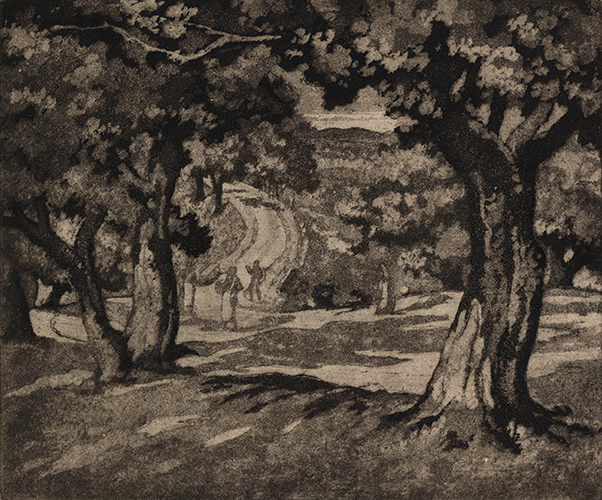Aquatint
From the period 1945-46, Safiuddin Ahmed composed only three paintings using Aquatint. Among them, there is a picture with a scene of Mayurakshi river, a picture of Dumka’s landscape and pigeons from Kolkata. He also painted the painting titled ‘Parabat’ (1945) in oil.

The aquatint medium requires patience and planning. The acid-fed metal varnish has to be thoroughly cleaned and rosin powder has to be applied on it. A special type of box is used to help apply the rosin powder evenly on the metal. The plate has to be heated to make the residual powder hard on the metal plate. In this case, if aquatint is not wanted in any part of the work, the parts have to be covered with varnish as before and after drying the varnish, the metal has to be treated with acid. This process of acid immersion has to increase or decrease to lighten or deepen the application of aquatint. And it has the application of different grades or levels of aquatint level or different tones. The use of rosin powder also results in a fine-spotted grainy effect. In order to bring these planned applications into the picture, the artist naturally has to show great restraint and skill.
Safiuddin Ahmed used to go to the coal depot in Baliganj, Kolkata to sketch. In a slum-like area, a pigeon’s nest was built on a bamboo pole with the wheel of a bullock cart. It had caught the artist’s attention and he sketched it and drew two paintings based on it. The image of ‘Parabat’ was first drawn in aquatint (here dry point was also used), then in oil paint Drawing with a needle in the form similar to dry point on the copper plate and then using the rosin powder in the aquatint method was used to enhance the granular effect. Applying light and thick coating of rosin powder a range of shades was achieved. For example, the bottom part of the wheel is kept completely black, since there is no light. On the other hand, the pigeons were completely white. The use of light and shadow has also become important in the work. The main beauty of the image is its composition. The wheel is slightly tilted to the right. The ropes capture the tension of the image. Its composition remained compact in its subject. No unnecessary element was added to it. The number of pigeons was also limited. Increasing the number of pigeons would reduce the overall appeal of the work, including the importance of the composition. Here the artist has to introduce himself through acceptance and rejection with a sense of extraordinary precision.

The uniqueness of the aquatint-painting, drawn with the ‘Dumkar Nisarga Drishya’ (1945), is the tree, the path through the middle of the tree, across the entire range of the painting. Ignoring the sky completely, the inner feeling of the universe has been given priority. The different parts of the white part of the path, the part of the grass in the field, the trunk of the tree, the shade and the part of the leaves have been clarified by making a difference in the use of rosin powder. The human figure has also been included. The image is also significant in the use of light and shadow.
There are two versions of the aquatint-painting (1945) of Mayurakshi; one light tone, another dark. In the first of these, in which the space between river and land is depicted through a cloudy white and the land is more grey and muddy. But in the second version,the water has many forms. In the dry season, the water of the Mayurakshi is waist level at some areas and at feet level others. The Santhal women would traverse for work through the hilly areas with ease. This scene was captured in the picture. The river bends twice. The parts of the hill where there are stones have been blackened. The artist’s deep observation is evident in the footprints on land he marked in the painting The white parts of the image in the second or final are particularly transparent and bright. The white fabric on the womens’ body,the bright parts of the river or hills due to the light of the sun falling on it were made transparent white with stop out.
After coming to Dhaka in 1947 and before moving to London in 1956, the artist drew only one aquatint-painting (there are also a few etching lines in this painting)– ‘Noukay Shunnya Kalash’ (1955). This is the picture of flood-hit Dhaka, notably of the artist’s hometown of Swamibagh. The Swamibagh area of Dhaka city still looked rural, covered with trees and brick houses with banana trees peeking from behind. In 1954 and 1955, two consecutive years of Dhaka was flooded, so boats were running freely. The image depicts the journey of fetching drinking water with an empty pitcher through the inundated area . In the centre of the picture are some empty boats tied up floating in the flood waters. As the flood has been given a realistic look with the skillful use of light and shadow. At the same time, various forms of dark black, light black and grey have been identified using various coatings of rosin powder. It has not been easy for the artist to make the varied plate flourish through this medium. The image also testifies his mastery in this medium.
Art historian and Art critic Professor Syed Azizul Huq, Chairman, Bangla Department, University of Dhaka
Translated by: Noshin Shamma and Priyanka Chowdhury
Edited by: Priyanka Chowdhury